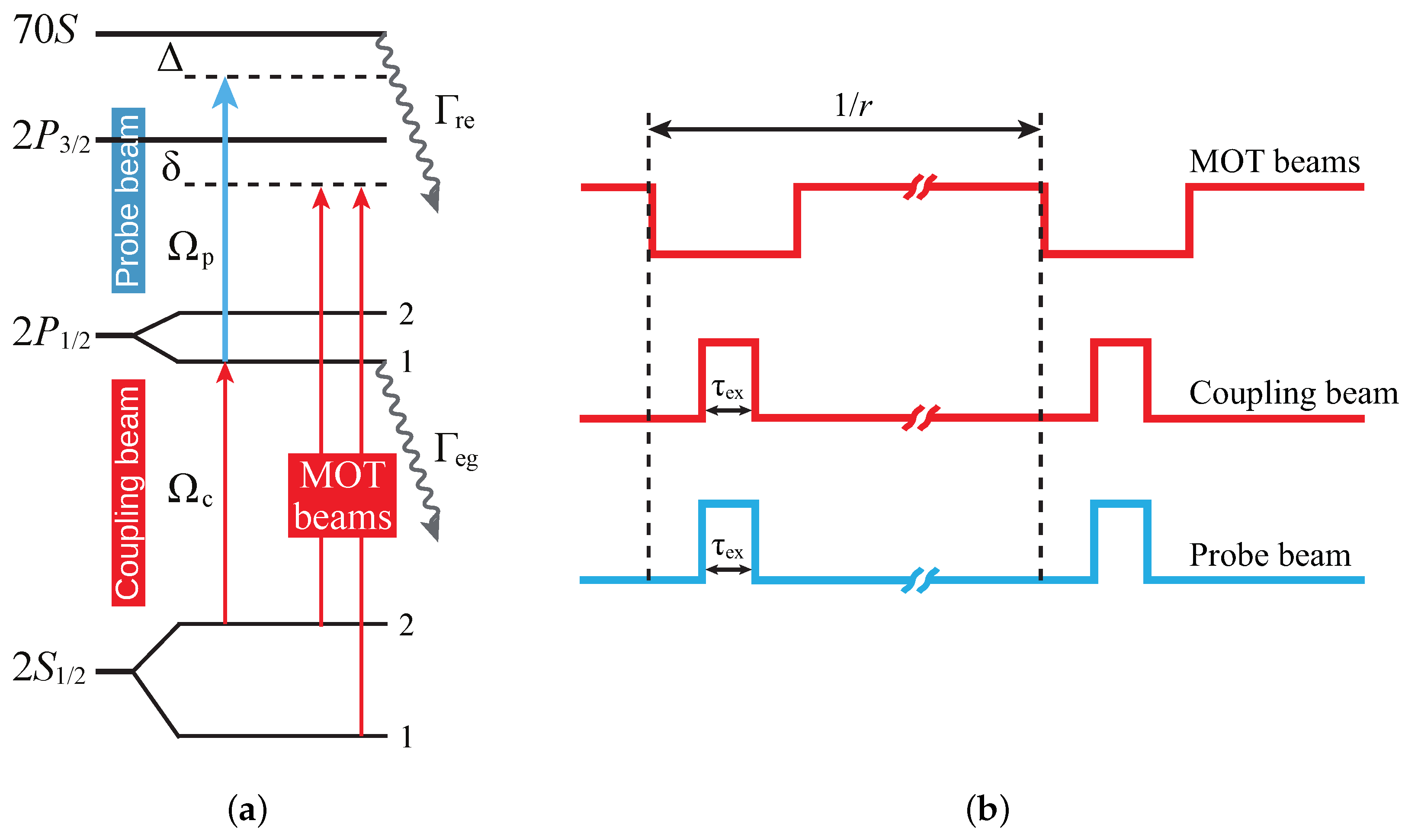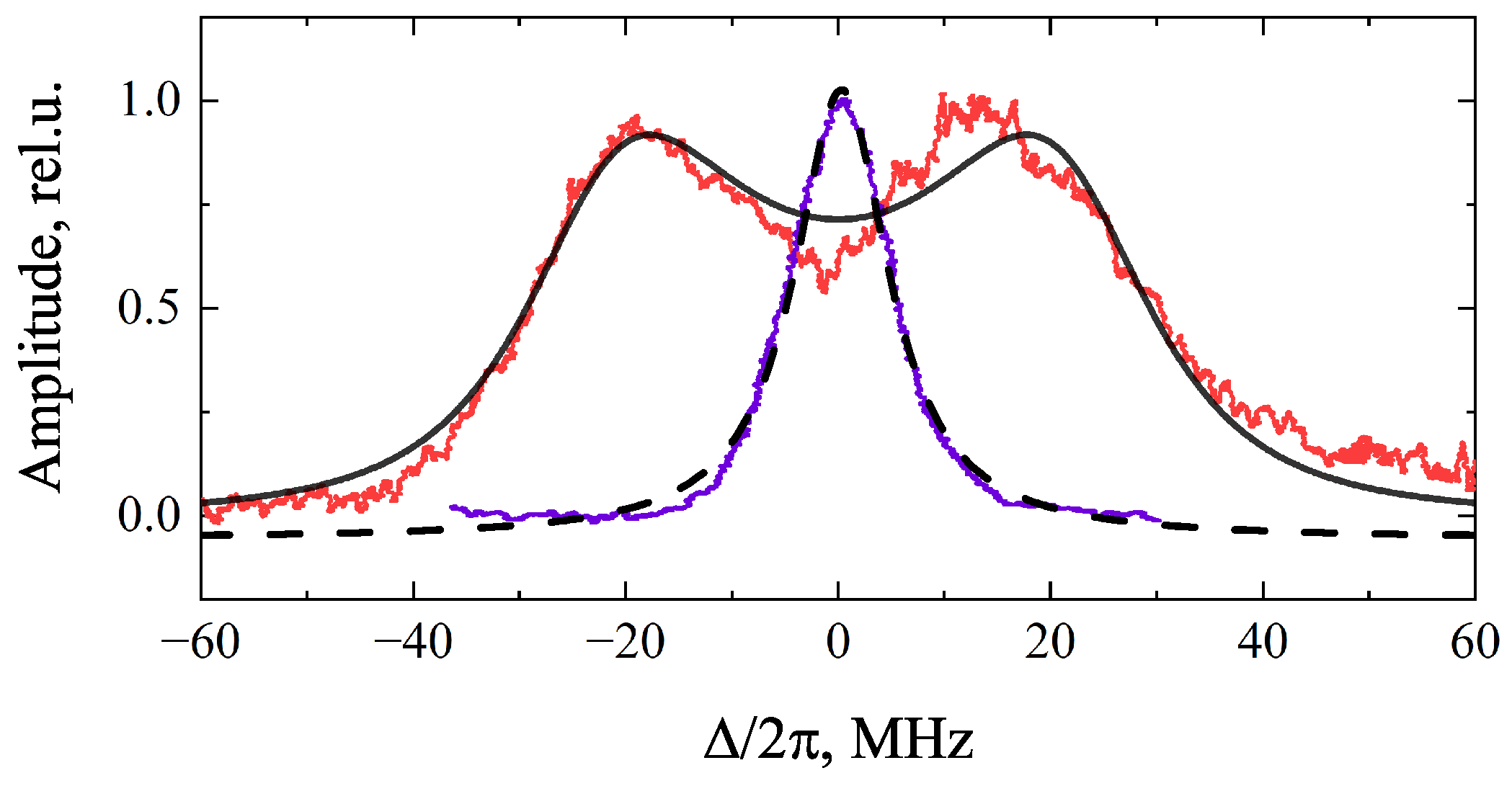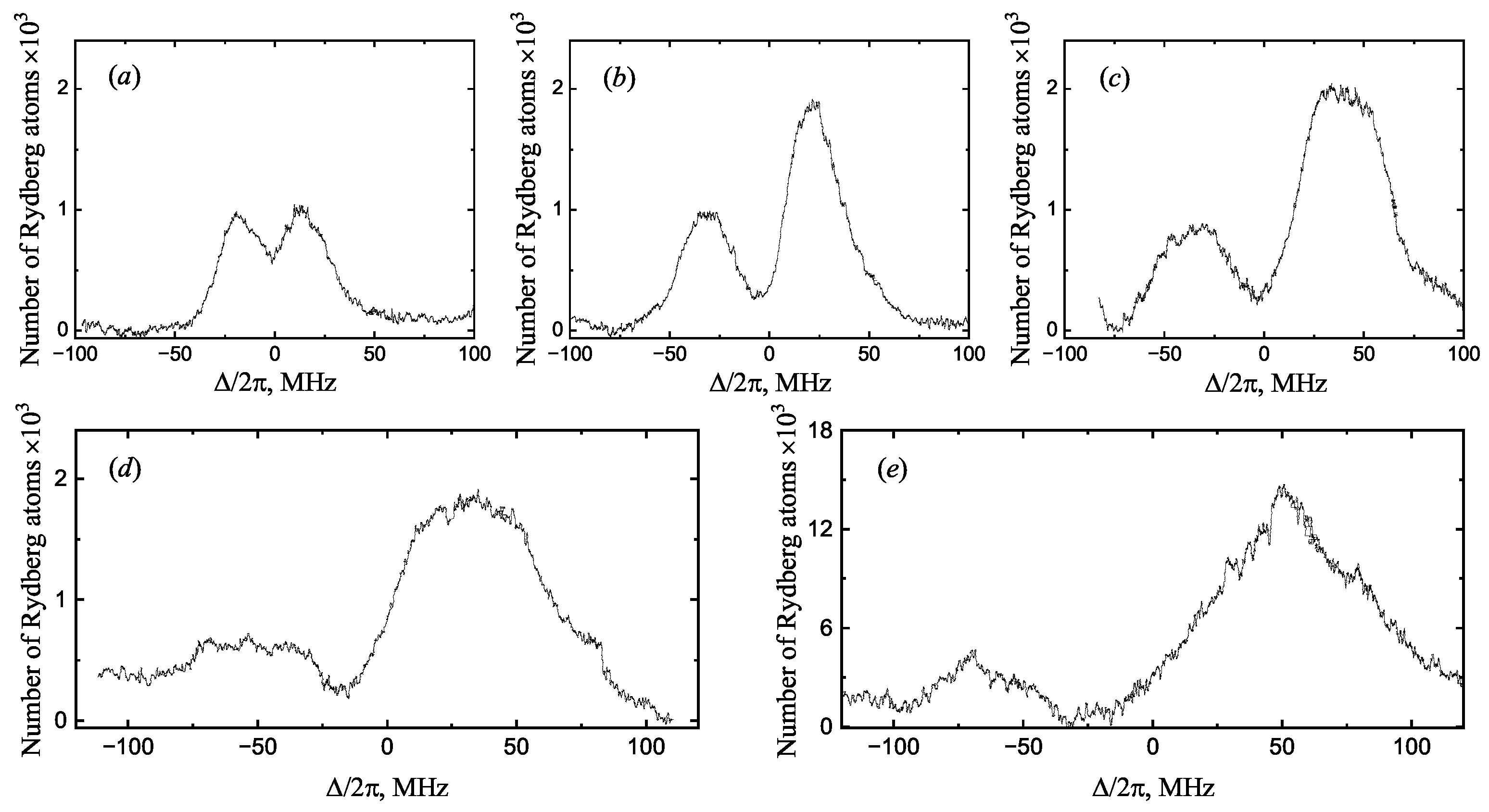Rydberg Interaction-Induced Distortion of the Autler–Townes Spectra in Cold Lithium Atoms
Abstract
1. Introduction
2. Experimental Setup and Methods
3. Results
4. Conclusions and Outlook
Author Contributions
Funding
Institutional Review Board Statement
Informed Consent Statement
Data Availability Statement
Conflicts of Interest
Abbreviations
| AT | Autler–Townes |
| BBR | Blackbody radiation |
| EIT | Electromagnetically induced transparency |
| FWHM | Full width at half maximum |
| MOT | Magneto-optical trap |
| RE | Rate equation |
| UV | Ultraviolet |
References
- Adams, C.S.; Pritchard, J.D.; Shaffer, J.P. Rydberg atom quantum technologies. J. Phys. B At. Mol. Opt. Phys. 2019, 53, 012002. [Google Scholar] [CrossRef]
- Cheinet, P.; Pham, K.L.; Pillet, P.; Beterov, I.I.; Ashkarin, I.N.; Tretyakov, D.B.; Yakshina, E.A.; Entin, V.M.; Ryabtsev, I.I. Three-body Förster resonance of a new type in Rydberg atoms. Quantum Electron. 2020, 50, 213–219. [Google Scholar] [CrossRef]
- Yakshina, E.A.; Tretyakov, D.B.; Entin, V.M.; Beterov, I.I.; Ryabtsev, I.I. Observation of the Dipole Blockade Effect in Detecting Rydberg Atoms by the Selective Field Ionization Method. J. Exp. Theor. Phys. 2020, 130, 170–182. [Google Scholar] [CrossRef]
- Letscher, F.; Thomas, O.; Niederprüm, T.; Fleischhauer, M.; Ott, H. Bistability versus metastability in driven dissipative Rydberg gases. Phys. Rev. X 2017, 7, 021020. [Google Scholar] [CrossRef]
- Wüster, S.; Ates, C.; Eisfeld, A.; Rost, J.M. Excitation transport through Rydberg dressing. New J. Phys. 2011, 13, 073044. [Google Scholar] [CrossRef]
- Gross, C.; Vogt, T.; Li, W. Ion imaging via long-range interaction with Rydberg atoms. Phys. Rev. Lett. 2020, 124, 053401. [Google Scholar] [CrossRef] [PubMed]
- Piotrowicz, M.J.; MacCormick, C.; Kowalczyk, A.; Bergamini, S.; Beterov, I.I.; Yakshina, E.A. Measurement of the electric dipole moments for transitions to rubidium Rydberg states via Autler–Townes splitting. New J. Phys. 2011, 13, 093012. [Google Scholar] [CrossRef]
- Günter, G.; Robert-de-Saint-Vincent, M.; Schempp, H.; Hofmann, C.S.; Whitlock, S.; Weidemüller, M. Interaction enhanced imaging of individual Rydberg atoms in dense gases. Phys. Rev. Lett. 2012, 108, 013002. [Google Scholar] [CrossRef]
- Anderson, D.A.; Miller, S.A.; Raithel, G.; Gordon, J.A.; Butler, M.L.; Holloway, C.L. Optical measurements of strong microwave fields with Rydberg atoms in a vapor cell. Phys. Rev. Appl. 2016, 5, 034003. [Google Scholar] [CrossRef]
- Duarte Gomes, N.; da Fonseca Magnani, B.; Massayuki Kondo, J.D.; Marcassa, L.G. Polarization Spectroscopy Applied to Electromagnetically Induced Transparency in Hot Rydberg Atoms Using a Laguerre–Gaussian Beam. Atoms 2022, 10, 58. [Google Scholar] [CrossRef]
- Zhang, H.; Wang, L.; Chen, J.; Bao, S.; Zhang, L.; Zhao, J.; Jia, S. Autler–Townes splitting of a cascade system in ultracold cesium Rydberg atoms. Phys. Rev. A 2013, 87, 033835. [Google Scholar] [CrossRef]
- Zhang, H.; Zhang, L.; Wang, L.; Bao, S.; Zhao, J.; Jia, S.; Raithel, G. Autler–Townes spectroscopy with interaction-induced dephasing. Phys. Rev. A 2014, 90, 043849. [Google Scholar] [CrossRef]
- Beterov, I.I.; Ryabtsev, I.I.; Tretyakov, D.B.; Entin, V.M. Quasiclassical calculations of blackbody-radiation-induced depopulation rates and effective lifetimes of Rydberg nS, nP, and nD alkali-metal atoms with n ⩽ 80. Phys. Rev. A 2009, 79, 052504. [Google Scholar] [CrossRef]
- Beterov, I.I.; Ryabtsev, I.I.; Tretyakov, D.B.; Bezuglov, N.N.; Ekers, A. Ionization of nS, nP, and nD lithium, potassium, and cesium Rydberg atoms by blackbody radiation. J. Exp. Theor. Phys. 2008, 107, 20–27. [Google Scholar] [CrossRef]
- Amthor, T.; Reetz-Lamour, M.; Westermann, S.; Denskat, J.; Weidemüller, M. Mechanical effect of van der Waals interactions observed in real time in an ultracold Rydberg gas. Phys. Rev. Lett. 2007, 98, 023004. [Google Scholar] [CrossRef]
- Bounds, A.D.; Jackson, N.C.; Hanley, R.K.; Bridge, E.M.; Huillery, P.; Jones, M.P.A. Coulomb anti-blockade in a Rydberg gas. New J. Phys. 2019, 21, 053026. [Google Scholar] [CrossRef]
- Robert-de Saint-Vincent, M.; Hofmann, C.S.; Schempp, H.; Gunter, G.; Whitlock, S.; Weidemüller, M. Spontaneous avalanche ionization of a strongly blockaded Rydberg gas. Phys. Rev. Lett. 2013, 110, 045004. [Google Scholar] [CrossRef]
- Siercke, M.; Oon, F.E.; Mohan, A.; Wang, Z.W.; Lim, M.J.; Dumke, R. Density dependence of the ionization avalanche in ultracold Rydberg gases. Phys. Rev. A 2014, 89, 022701. [Google Scholar] [CrossRef]
- DeSalvo, B.J.; Aman, J.A.; Gaul, C.; Pohl, T.; Yoshida, S.; Burgdörfer, J.; Hazzard, K.R.A.; Dunning, F.B.; Killian, T.C. Rydberg-blockade effects in Autler–Townes spectra of ultracold strontium. Phys. Rev. A 2016, 93, 022709. [Google Scholar] [CrossRef]
- Vidal, C.R.; Cooper, J. Heat-Pipe Oven: A New, Well-Defined Metal Vapor Device for Spectroscopic Measurements. J. Appl. Phys. 1969, 40, 3370–3374. [Google Scholar] [CrossRef]
- Olivares, I.E.; Gonzalez, I.A. Diode laser absorption spectroscopy of lithium isotopes. Appl. Phys. B 2016, 122, 1–7. [Google Scholar] [CrossRef]
- Schünemann, U.; Engler, H.; Grimm, R.; Weidemüller, M.; Zielonkowski, M. Simple scheme for tunable frequency offset locking of two lasers. Rev. Sci. Instrum. 1999, 70, 242–243. [Google Scholar] [CrossRef]
- Sautenkov, V.A.; Saakyan, S.A.; Bobrov, A.A.; Vilshanskaya, E.V.; Zelener, B.B.; Zelener, B.V. Differential two-photon spectroscopy for nondestructive temperature measurements of cold light atoms in a magneto-optical trap. J. Opt. Soc. Am. B 2018, 35, 1546–1551. [Google Scholar] [CrossRef]
- Sautenkov, V.A.; Saakyan, S.A.; Bobrov, A.A.; Kudrinskiy, D.A.; Vilshanskaya, E.V.; Zelener, B.B. Optical Dipole Trap for Laser-Cooled Lithium-7 Atoms. J. Russ. Laser Res. 2019, 40, 230–236. [Google Scholar] [CrossRef]
- Bobrov, A.A.; Saakyan, S.A.; Sautenkov, V.A.; Vilshanskaya, E.V.; Zelener, B.V.; Zelener, B.B. Determination of characteristics of a magneto-optical trap by the spectral width of coherent two-photon resonance. Quantum Electron. 2018, 48, 438–442. [Google Scholar] [CrossRef]
- Das, D.; Natarajan, V. Absolute frequency measurement of the lithium D lines: Precise determination of isotope shifts and fine-structure intervals. Phys. Rev. A 2007, 75, 052508. [Google Scholar] [CrossRef]
- Magnus, F.; Boatwright, A.L.; Flodin, A.; Shiell, R.C. Optical pumping and electromagnetically induced transparency in a lithium vapour. J. Opt. B Quantum Semiclassical Opt. 2005, 7, 109–118. [Google Scholar] [CrossRef]
- Saakyan, S.A.; Sautenkov, V.A.; Zelener, B.B. Long-term frequency stabilized and linewidth-narrowed cw-laser system for excitation of lithium Rydberg states. J. Phys. Conf. Ser. 2018, 946, 012128. [Google Scholar] [CrossRef]
- Robertson, E.J.; Šibalić, N.; Potvliege, R.M.; Jones, M.P.A. ARC 3.0: An expanded Python toolbox for atomic physics calculations. Comput. Phys. Commun. 2021, 261, 107814. [Google Scholar] [CrossRef]
- Raitzsch, U.; Heidemann, R.; Weimer, H.; Butscher, B.; Kollmann, P.; Löw, R.; Büchler, H.P.; Pfau, T. Investigation of dephasing rates in an interacting Rydberg gas. New J. Phys. 2009, 11, 055014. [Google Scholar] [CrossRef]
- Singer, K.; Stanojevic, J.; Weidemüller, M.; Côté, R. Long-range interactions between alkali Rydberg atom pairs correlated to the ns–ns, np–np and nd–nd asymptotes. J. Phys. B At. Mol. Opt. Phys. 2005, 38, S295–S307. [Google Scholar] [CrossRef]



Disclaimer/Publisher’s Note: The statements, opinions and data contained in all publications are solely those of the individual author(s) and contributor(s) and not of MDPI and/or the editor(s). MDPI and/or the editor(s) disclaim responsibility for any injury to people or property resulting from any ideas, methods, instructions or products referred to in the content. |
© 2023 by the authors. Licensee MDPI, Basel, Switzerland. This article is an open access article distributed under the terms and conditions of the Creative Commons Attribution (CC BY) license (https://creativecommons.org/licenses/by/4.0/).
Share and Cite
Saakyan, S.; Morozov, N.; Sautenkov, V.; Zelener, B.B. Rydberg Interaction-Induced Distortion of the Autler–Townes Spectra in Cold Lithium Atoms. Atoms 2023, 11, 73. https://doi.org/10.3390/atoms11040073
Saakyan S, Morozov N, Sautenkov V, Zelener BB. Rydberg Interaction-Induced Distortion of the Autler–Townes Spectra in Cold Lithium Atoms. Atoms. 2023; 11(4):73. https://doi.org/10.3390/atoms11040073
Chicago/Turabian StyleSaakyan, Sergey, Nikita Morozov, Vladimir Sautenkov, and Boris B. Zelener. 2023. "Rydberg Interaction-Induced Distortion of the Autler–Townes Spectra in Cold Lithium Atoms" Atoms 11, no. 4: 73. https://doi.org/10.3390/atoms11040073
APA StyleSaakyan, S., Morozov, N., Sautenkov, V., & Zelener, B. B. (2023). Rydberg Interaction-Induced Distortion of the Autler–Townes Spectra in Cold Lithium Atoms. Atoms, 11(4), 73. https://doi.org/10.3390/atoms11040073






